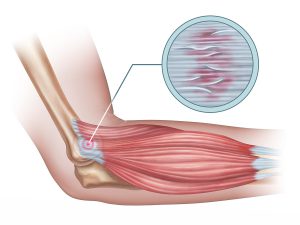
In this edition of ‘TIC Spotlight’ we take a closer look at a common condition affecting the outside of the elbow “Tennis Elbow”, or to give it it’s medial name “Lateral Epicondylitis”. It is estimated that tennis elbow affects 1 in 3 people, however, despite its name only 5% of individuals suffering with tennis elbow can actually relate the cause of injury to tennis! Read on to understand what might be causing your tennis elbow and how you can manage the symptoms!
Tennis Elbow
What is it?
Tennis elbow (lateral epicondylitis) is the most common overuse injury which affects the elbow. The term lateral epicondylitis indicates that this condition affects the outside of the elbow and is the result of inflammatory reaction or in more longterm cases micro-trauma in the tendon. Symptoms of tennis elbow can typically be experienced from 2 weeks up to 2 years, with most cases being resolved within 1 year.
Symptoms
As tennis elbow is an overuse condition that develops over time, symptoms can vary dependant on the stage of injury.
The four stages to the development of lateral epicondylitis are defined by the following symptoms;
- Faint pain a couple of hours after the provoking activity
- Paint at the end of or immediately after the provoking activity
- Pain during the provoking activity, which intensifies once you have stopped the activity
- Constant pain, which prevents the ability to perform activity involving the affected arm
The most common complaints associated with tennis elbow include;
- Pain located around the outside of the elbow
- Tenderness around the outside of the elbow when pressed.
- Reduction in strength which is often reported as weakness in grip strength
- Stiffness and difficulty straightening the arm after periods of inactivity.
Causes
Tennis elbow develops when muscles and tendons in the elbow and forearm are subjected to overuse. The main muscles involved originate at the elbow, run down the forearm and insert around the wrist. This means any repetitive movements involving the wrist, forearm and elbow such as typing, twisting and lifting weight can cause the development of tennis elbow. Injury is often work related, especially for manual/office workers who perform repetitive movements and/or those handling weight regularly.
Common risk factors that increase the chance of developing tennis elbow include
- Handling tools heavier than 1kg
- Handling loads heavier than 20kg regularly throughout the day
- Repetitive movements for more than 2 hours per day
- Training errors
- Misalignments of the involved joints
- Flexibility problems
- Ageing
- Poor circulation
- Strength deficits and/or muscles imbalance
Tennis elbow is most common in 35-50 year olds and rarely occurs in both arms, the dominant arm has the greatest chance of occurrence; however starting a new repetitive task with your weaker arm is also a common cause in the case we see in the clinic.
Common Myths
You can only get tennis elbow if you play tennis…. False!
There is a greater chance you can sustain tennis elbow from daily or work activities than there is from playing tennis!
You have to completely rest when you have tennis elbow… False!
Although activities will need to be modified to prevent further aggravation, strengthening exercises are encouraged through a home exercise programme to re-structure the damaged tendons.
How is it treated?
Most cases of tennis elbow are treated using conservative methods and there is no need for surgery. However, if conservative treatment fails after a minimum period of 6 months then surgery will be considered.
Initial treatment is based on the principles of relieving pain and controlling inflammation. A steroid injection may be used alongside conservative treatment at this stage and has been found to have a beneficial effects lasting for approximately 3 months. However, this will not resolve the injury alone and after roughly 2 weeks rest following the injection, it is important that a gradual loading programme is continued during this time.
Different types of therapies are used to treat tennis elbow, all with the same aim to reduce pain, load the tendon and improve function. Before undertaking any form of conservative treatment, it is important to gain a comprehensive understanding of how to control pain and which activities may need to be modified to avoid on-going aggravation of symptoms.
Common therapies include;
- Manual Therapy techniques to improve pain free range of movement
- Therapeutic ultrasound
- Taping techniques
- Shockwave therapy
- Deep tissue massage techniques
- Medial acupuncture
- An exercise programme including loading, strengthening and stretching
What Can You Do?
In the early stage applying ice for a maximum period of 15 minutes 3 times per day will help to reduce inflammation around the elbow and reduce pain.
Stretching the involved muscles around the elbow and wrist will reduce tension placed on the irritated tendons.
- Begin with your arm straight out in front of your with your palm facing up to the ceiling
- Using your other hand bend your wrist so your fingers are pointing towards the floor, you should feel a mild to moderate stretch in your forearm
- Hold for 10-20 seconds, repeat 3 times.
Avoid any aggravating movements that involve repetitive wrist, forearm and elbow actions. This may mean adapting daily or work activities!
If you’ve found the information in this article interesting and are wondering what else we can help you with? Then please feel free to get in touch with us here at the clinic.
